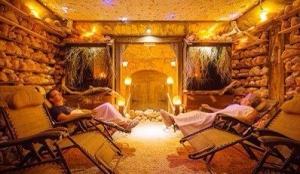Salt Cave
When we talk about salt caves and salt grottos, we are discussing first and foremost is an interior décor designed to transport us beneath the surface of the planet.
The stalactites, the walls of salt, the dim illumination of salt lamps accentuating some of the features, the relaxing music in the background, the atmosphere enhanced by a miscellany of sound effects, all cause us to feel that we are in a natural cave or mine. So it’s hardly surprising that any number of people drift off to sleep on the loungers. Like any form of relaxation, a visit to a salt cave or grotto can improve our mood and reduce stress.
But will it be therapy? In order to obtain therapeutic results, it is essential for the air to be rich in salt aerosol.
The first publications confirming the efficacy of halotherapy appeared thanks to the work of Dr Feliks Boczkowski. It was he who, on the basis of analyses and observation of the miners working in the salt mine in Wieliczka, ascertained the positive impact on health of the dry salt aerosol which was the product of the miners’ work.
A salt cave has the potential of being a facility with a wide spectrum of health-giving effects. It can have an excellent impact on the human body. However, this will only happen if the ‘cave’ is filled with genuine, dry salt aerosol. Which is where the Salsano DC-405 halogenerator comes into play. Dry salt aerosol can only be produced above ground by a halogenerator. There is no other way.
Something else that needs emphasising is the fact that salt caves are usually fairly modest spaces in which a large number people spend time. Given the accumulation of bacteria and viruses exhaled by the participants in a session, maintaining an antibacterial environment is imperative. Otherwise, what might well occur is the mutual spread of infections among the users. Wet sodium chloride aerosol obtained as a result of atomising a saline solution is not an active bactericide. Only the presence of dry salt aerosol can provide an antibacterial environment. And your fast route to that environment is the SALSANO DC-405 halogenerator.
Despite the fact that, in Poland, we have world-renowned sanatoria endowed with natural, underground salt caves, knowledge regarding the absolute necessity of equipping above-ground chambers with a generator was really rather minimal until recently.
The past few years have seen a boom in caves constructed using chips of salt and with a ventilation system fitted between the walls. Heating the salt-sprinkled floor is intended to release the salt aerosol. However, scientific studies have unequivocally shown that it is impossible to create a microclimate with the characteristics of a salt chamber by these kinds of methods. At best, all they can produce are minute traces of low-quality aerosol.
Then there is the fact that salt aerosol particles retain their negative charge for no more than one hundred seconds or so after micronisation. So the salt must be micronised and delivered as a dry aerosol to the halotherapy room systematically. Which is just what the Salsano DC-405 does.
Decorations reflecting natural salt caves are often created using salt chips, wood and a special plaster-and-salt mix. Stalactites are most often recreated using wire and polyurethane foam, which is relatively easy to work with. Once the shape has been achieved, it is painted with emulsion and then the salt-and-plaster mix is added. It is always best to try and use construction materials which are certified for use in places designed to accommodate people and to use them in the way intended. Then the end result will be safe and can be glorious to see. However, what it cannot do is produce dry salt aerosol.
